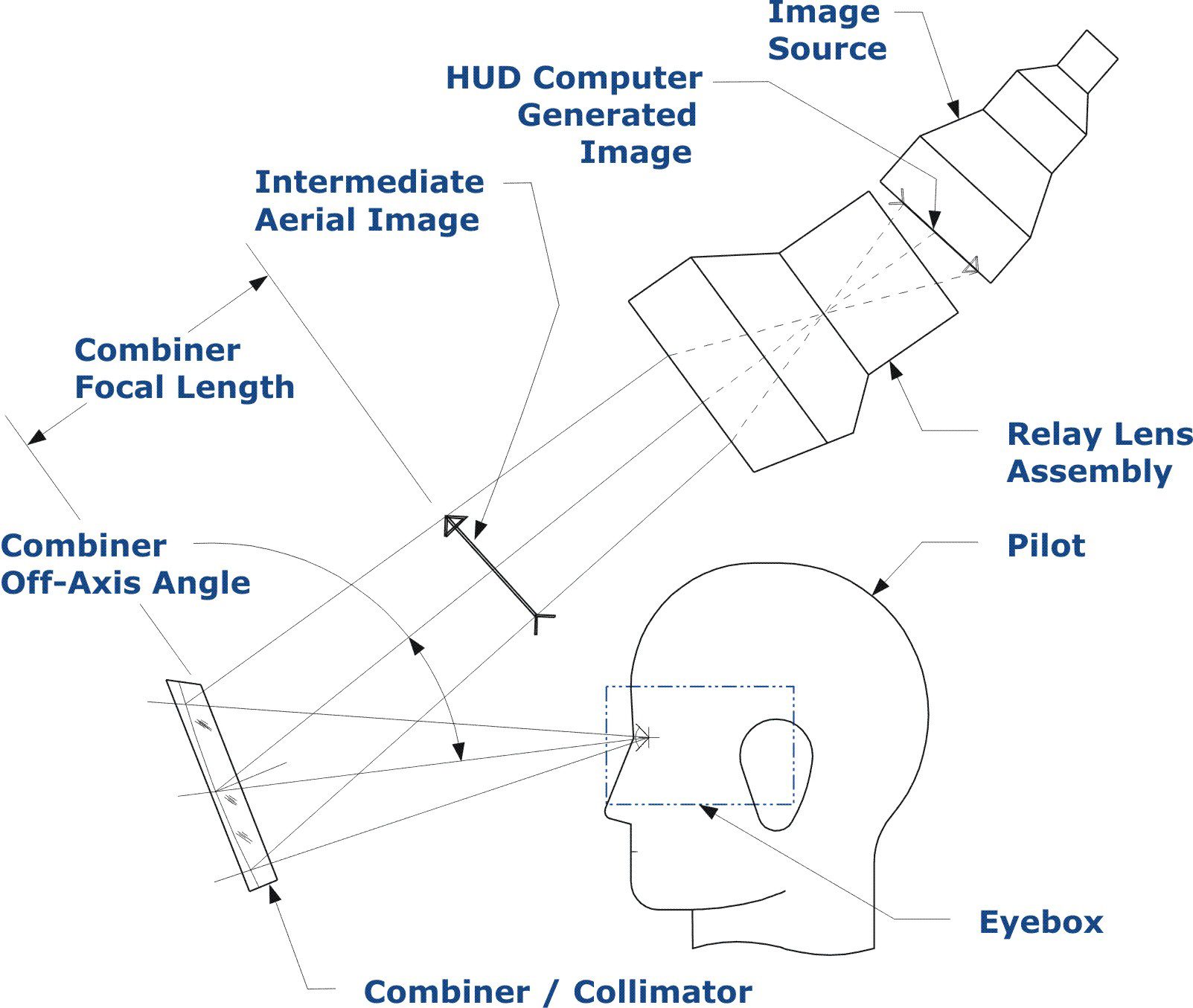The Heads-Up-Display is a Human-Machine-Interface (HMI) that relays real time information related to the vehicle, traffic and associated environment for an assisted driving experience.
There are two types of Head-up Display (HUD):
- Combiner glass HUD – this uses a partially reflective screen like glass to display information in the line of sight of the driver
- Windshield HUD – this uses the windshield of the glass to display necessary information in the line-of-sight of the driver.
In case of a Combiner Glass HUD, the type of combiner glass used differs depending upon the manufacturing specifications.
The Physics and Optics behind the Combiner Glass HUD:

Schematic representation of the HUD mechanism
Image Source: SPIE Article
The holographic combiner is designed specifically for commercial vehicles. A typical Augmented Reality HUD consists of a reflective optical system.
This system is a combination of two distinct optical subsystems.
- The first part is the Image Source / Picture-Generating Unit (PGU). The PGU creates a digital image to be directed to the relay lens assembly.
The relay lenses are designed to re-image the input from the PGU into an intermediate image that then reaches the combiner glass through a reflector.
- The semi-transparent Combiner constitutes the second part of the reflective optical system. It plays an important part in re-imaging the intermediate image to be viewed by the driver.
The basic mechanism of the combiner glass (which is part of the optical subsystem) can be explained as follows:
- The Combiner glass is a partially transparent display that mixes the digital images with the real-world to facilitate Augmented Reality.
- To reach the driver’s eye the light rays needs to bounce off a reflective surface.
- The HUD system generates artificial/ digital light and re-directs it on the display, also the real world light is re-directed on the same surface.
- Therefore, this optical surface that combines the artificially generated image with the real world is called combiner.
Different types of Combiner glasses:
Based on the underlying technology principle, the Combiner glass can be categorized as,
- Conventional optical combiners
- Waveguide combiners.
Conventional combiners: These produce a reasonable visibility and image quality with consistent performance.
Conventional combiners can be further categorised into two types, polarized beam and off-axis combiners on the basis of implementation.
Waveguide combiners: Waveguide combiners are regarded as a technically sophisticated optical hardware solutions that are usually hard to design.
Waveguide combiners work on non-conventional techniques like holographic and diffractive optics, unlike conventional combiners which use the concept of reflection and refraction.
Applications of Smart Glasses and their market potential:
Smart Glasses are interfaces that display additional information to the real world view of the user and hence deliver the experience of Augmented Reality (AR).
These Smart Glass interfaces are integral part of optical head-mounted display (OHMD) or wireless embedded glasses with partially transparent wireless HUD.
A research analysis report by Markets and Markets predict the value of smart glasses market to be USD 8.13 Billion by 2022.
The market is expected to grow at a CAGR of 19.2% between 2016 and 2022
Combiner Glass, an interface (HMI) of Car Heads-up Display (HUD), is a type of Smart Glass.
Combiner Glass is a preferred choice for installations of Head-up Display in military, aviation and luxury commercial cars applications.
According to a survey by Transparency Market Research (TMR) the global market of HUD will expand at 19.1% CAGR between 2015 and 2022.
The global heads-up display market is estimated to reach USD 7.05 Billion by 2022.
Related Posts: Learn more about Car Heads-up Display (HUD):
Automotive Heads-up Display (HUD) is a very interesting product. At Embitel, we have developed a Combiner HUD design after intense R&D of 4 years and investments in embedded, cloud and mobility technologies.
We encourage you to learn more about this interesting space of in-vehicle Head-up Display (HUD). Here are some interesting articles:
- What is Car HUD system? Learn about all the critical hardware modules
- What is heads-up display (HUD) for Cars? Learn about the embedded software, device drivers and stacks
- Car HUD embedded software, hardware design – an EFY analysis
- HUD (Heads-up Display) Apps for Android/iOS – an analysis and comparison


